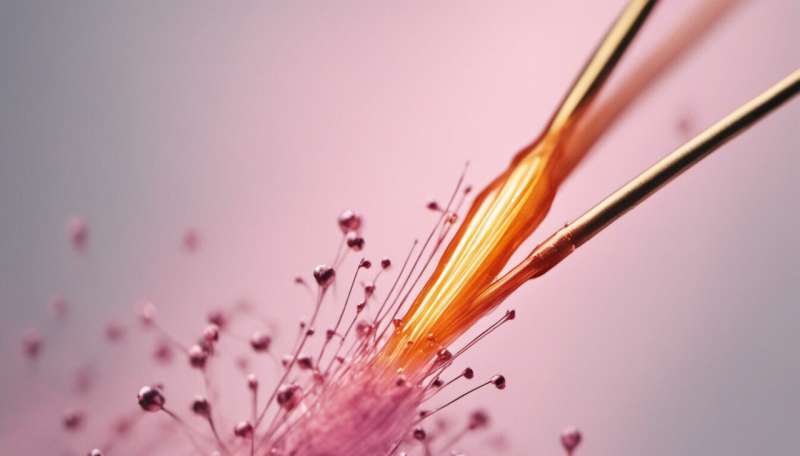A COVID-19 vaccine may come without a needle, the latest vaccine to protect without jabbing

Vaccinesare traditionally administered with a needle, but this isn't the only way. For example, certain vaccines can be delivered orally, as a drop on the tongue, or via a jet-like device.
Vaccines that appear particularly suitable toneedle-free technology are DNA-based ones, includinga COVID-19 vaccinebeing developed in Australia.
Needle-free vaccines are attractive as they cause less pain and stress to people with needle phobias. But they have other benefits.
Jet injectors and beyond
Theearliest needle-free injection systemsdate back to 1866 and used jet injectors. These hand-held devices used pressure to penetrate the skin and deliver medicine.
They becameincreasingly populararound the middle of the 20th century, and were used to deliver vaccines against typhus, polio and smallpox.
A hepatitis B outbreak linked to their use meant they were discontinued in the 1980s. However, research picked up again in the 1990s. Variations included a spring-loaded jet injector (a spring is released to deliver the drug), a battery-powered jet injector, and a gas-powered jet injector.
Jet injection has also been usedin dental careto deliver local anesthetic.
Beyond jet injection,oral vaccinesincludingrotavirus, cholera, polio and typhoid have been around for several decades, and are still used today in various parts of the world. They can come as a liquid or tablet.
More recently, researchers and biotechnology companieshave developedvaccines you inhale, such as nasal sprays, as well asskin patches. These are mostly still in clinical testing.
DNA-based vaccines and the gene gun
DNA vaccines were a chance discovery as a result ofearly gene therapy experimentsin the 1990s, where injecting DNA into the muscle unexpectedly generatedan immune response.
With a DNA vaccine, a small section of the genetic material of the virus is delivered into cells under the skin. These cells then express the DNA as viral proteins. The body recognizes these as foreign and stimulates an immune response.
DNA vaccinesare simple and cheap to produce in large quantities, and they're relatively safe as they don't contain any infective agents, such as live virus.
,
Scientistshave exploreda number of ways to deliver DNA vaccines, either with a needle or needle free.The needle-free methods includeultrasound (sound waves) and electroporation (electrical pulses) that disrupt cell membranes, allowing DNA into the cells.
The gene gun or "biojector 2000," a form of jet injector, seems to be the most effective method.This usespressure to inject DNA into deep layers of the skin. Because it improves the distribution of the vaccine deeper into the injection site, this method uses far less DNA than injection with a needle to generate the same immune response.
But no DNA vaccine has been licensed for use in humans yet. Although needle-free DNA vaccines have shown success in pre-clinical and early clinical trials, DNA vaccines in generalare also not as effectivein generating immune responses against diseases such as HIV and cancer.
Needle-free COVID-19 contenders
The University of Sydney recently receivedfederal government fundingto commencehuman trialsusing a "liquid jet"injectorto deliver its DNA-vaccine.
liquid jet injectors use small volumes of liquid forced through a tiny opening (smaller than a human hair). This ultra-fine high pressure stream penetrates the skin where cells then take up the vaccine and stimulate immune cells.
This method was effective in several clinical trials againstHIVand is currently used to deliver someinfluenza vaccines.
Other needle-free COVID-19 vaccines in development include abandaid-like patchmade up of 400 tiny needles, anasal vaccine, an oral vaccine as atablet, and aneedle-free devicethat delivers an mRNA vaccine.
Vaccines based on mRNA work in similar ways to DNA vaccines.
Advantages and disadvantages
Theadvantagesof needle-free vaccine technology, specifically jet injectors, include:
- they may be significantly more acceptable for people afraid of needles, including children
- there's no risk of beingaccidentally injuredwith a needle
- they eliminate needle disposal (up to 500 million needles are thrown inlandfill every yearafter vaccinations, and 75 million of these could be infected with blood-borne diseases)
- they improve vaccine delivery into the skin and use a lower vaccine volume.
Disadvantagesinclude:
- start-up costs for those using the device, including buying gun devices, and access to gas/air systems to power them
- staff who administer thevaccinewill need special training, and may not feel confident using the technology
- the equipment needs regular maintenance.
Explore further
This article is republished fromThe Conversation基于知识共享许可协议。读了original article.![]()


















User comments